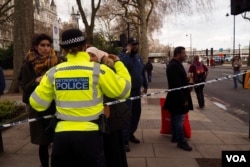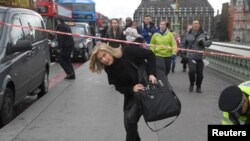As the gunshots cracked out, a bystander muttered a fearful, “Jesus Christ.” Others, tourists and office workers, already wondering why an SUV would ram the railings of Britain’s storied House of Commons, started to flee, some screaming.
Under the shadow of Big Ben, a policeman who moments earlier had confronted a knife-wielding assailant died from his stab wounds. Meters away, his attacker, said by eyewitnesses to be middle-aged and Indian or Pakistani in appearance, was mortally wounded after having been shot by other armed police officer.
On Westminster Bridge, scattered bodies lay in pools of blood on the sidewalk or in the road after having been plowed into by a speeding SUV. One man ended up spread-eagled at the bottom of stone steps that lead to the embankment along the River Thames.
Inside the chamber of the House of Commons, lawmakers suspended a debate on pension reform. Just a half-hour earlier they had been listening to Chris Grayling, the transport minister, talk about why the government had decided to join the U.S. in banning laptops and other electronic items being carried in the cabins of passenger jets flying from a half-dozen Mideast and North African airports.
Britain faces a “constantly evolving terror threat,” he explained to lawmakers.
That was underlined minutes later by crumpled bodies and gunshots, the desperate stabbing and the ramming of pedestrians on nearby Westminster Bridge and in bustling Parliament Square.
Quick response
Britain’s counter-terror squad and other armed specialist units responded quickly to the incident, locking down the Palace of Westminster as a calm David Lidington, the leader of the House of Commons, explained why proceedings had to be suspended.
Theresa May, who had been in an adjacent voting lobby when the gunfire erupted, was immediately surrounded by plainclothes bodyguards who drew their weapons as they escorted her out of the building, according to Conservative lawmaker Andrew Bridgen.
As counter-terror police scrambled to understand the scale of the attack and to establish whether the assailant had acted alone, senior officers from London’s Metropolitan police already were launching a parallel probe to outline provisional lessons from the worst terror incident involving Britain’s parliament in nearly 40 years.
In 1979, the Irish republicans managed to blow up in Old Palace Yard Airey Neave, a confidant of then newly elected British Prime Minister Margaret Thatcher. It was after that bombing that Parliament took on the appearance of a fortress. Security was ramped up and many of the security procedures still in use today can de dated from that bombing, although with dramatic updates as needed in the light of the threat from jihadists.
Lone wolf?
Anticipation is one thing, making sure an attacker doesn't breach again the grounds of the Palace of Westminster is another. As one senior policeman told VOA, any obvious gaps in security need to be plugged quickly in case Wednesday’s attack was a prelude to another.
“We still don’t know whether the assailant was a 'lone wolf' or part of an operation with others, who may be planning to follow up,” he said. “We have to take into account what happened recently in Brussels and Paris, where there was coordination. Or is this more like Nice,” he added, referring to last year’s terror attack on the French coast.
Police know the identity of the assailant, say British security sources, and have visited his home as well as the houses of friends and known associates.
Mark Rowley, the acting deputy commissioner who oversees Britain’s counter-terrorism police, said: “A crime scene will remain in place in the affected areas in Westminster - it is vital that we carry out a painstaking investigation to recover all possible evidence.”
Not unexpected
Labor Party activist Gary Kent, who has worked in the British Parliament for 25 years and is director of the all-party parliamentary group on the Kurdistan Region, said he remained shaken but not entirely surprised. “Today has taken a long time but I have anticipated it or something like it on many occasions,” he said.
Peter Kirkham, a former police commissioner, said the security procedures were successful, adding that the attacker managed “to breach the outer security cordon but was then stopped.”
When they were allowed to leave the Palace of Westminster, lawmakers sang the praises of the police, saluting them for rushing to the danger as they ordered everyone else to move away.
Labor lawmaker Barry Gardiner said: “The security protocols worked well.”
Lessons to be learned
But there will be lessons to be learned from the attack. A security review will likely see some changes. One upshot, says a senior security official, may be a decision to turn Parliament Square into a pedestrian precinct and to establish another barrier beyond the railings surrounding the building, thus making it harder for an attacker to rush into Old Palace Yard.
Wednesday’s attack is dismaying for security officials. Despite Britain being seen as a prime target, this is the first act of terrorism since 2013, when self-proclaimed jihadists hacked to death an off-duty British soldier in a London street. Vigilance and surveillance and quick detection of those who have become radicalized have helped prevent terrorism. Since 2009 there have been nearly 300 successful prosecutions of militants and would-be terrorists.
But however good counterterror tactics and policing are, however much capabilities are improved, there can’t be foolproof security. The attack on Britain’s parliament once again underlines how easy it is to pull off devastating assaults - all an attacker needs is a vehicle and a knife. “It is always open to any lunatic with a fanatical outlook on life to mount an attack against innocent people in pursuit of their fixations,” lamented Conservative lawmaker Julian Lewis.








